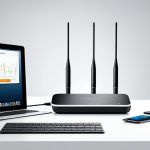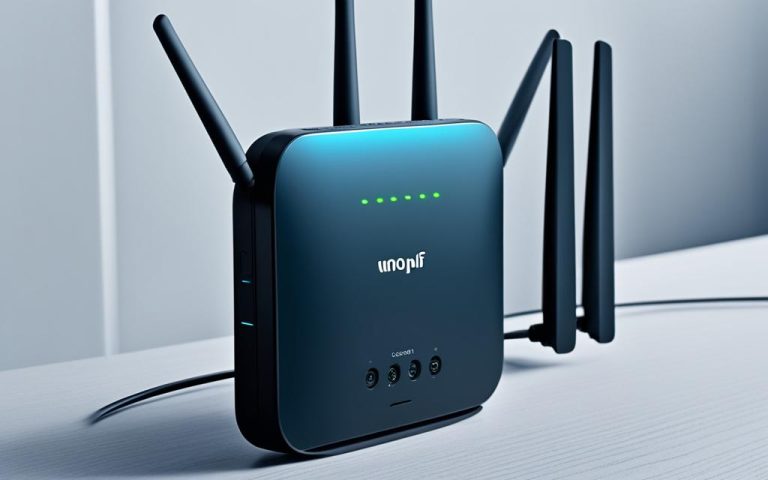Streaming media has transformed the way we consume digital content in today’s digital and internet era. It has revolutionized traditional distribution methods and offers personalized strategies for connecting with audiences. Leading platforms like Netflix and Tencent Video recognize the value of user-generated data and its impact on content creation, distribution, and algorithm adaptation.
Utilizing Personal Area Networks (PANs) can enhance the streaming and sharing experience across devices, providing seamless connectivity and access to multimedia content. PANs enable easy sharing and streaming of media, ensuring a smooth and uninterrupted viewing experience. With PANs, users can enjoy their favorite movies, music, and other multimedia content anytime and anywhere.
In this article, we will explore the rise of streaming media, the various business models in the industry, and analyze the practices of leading streaming service providers like Netflix and Tencent Video. Additionally, we will delve into the importance of audience participation and the different types of networks that facilitate multimedia consumption.
Stay tuned to learn more about the benefits of utilizing PANs for streaming and sharing, and how it can enhance your multimedia consumption experience.
The Rise of Streaming Media
Streaming media has revolutionized the way we consume digital content. It has emerged at the intersection of the digital transformation of media content production and the comprehensive platforming of the cultural industries. Streaming platforms offer a variety of media forms, including music, film, news, and radio, which are produced and distributed digitally in national and international markets. Video streaming has gained significant attention from academia and is seen as a key example of contemporary digital media. Streaming platforms like Netflix and Tencent Video are leading the way in this digital revolution, offering diverse business models and subscription options to cater to different audience preferences.
Streaming media has drastically changed the landscape of digital content consumption. With the advent of streaming platforms, traditional methods of distributing media have been challenged, giving rise to customized and personalized strategies for connecting with audiences. These platforms, such as Netflix and Tencent Video, recognize the value of user-generated data and its impact on content creation, distribution, and algorithm adaptation.
Streaming platforms have successfully tapped into the digital transformation of media content production. They provide a comprehensive platforming approach that covers various forms of media, from music to film, news to radio. These platforms have embraced the digital nature of media production and distribution, catering to national and international markets.
“Streaming platforms have become major players in the global market, offering diverse business models and subscription options to cater to different audience preferences.”
Video streaming, in particular, has become a key example of contemporary digital media. It has garnered significant attention from academia and is considered a game-changer in the industry. Platforms like Netflix and Tencent Video have pioneered the way for video streaming, offering a wide range of content and innovative business models.
Netflix: Redefining Video Streaming
Netflix, the industry leader in video streaming, has redefined the way we consume digital content. With over 230 million subscribers worldwide, Netflix offers a comprehensive library of movies, TV shows, and original content. Its success lies in its ability to provide tailored recommendations and a seamless user experience.
Tencent Video: Leading the Digital Revolution
Tencent Video, a streaming platform based in China, is also making waves in the industry. With over 161 million subscribers worldwide, Tencent Video offers a wide range of content, including movies, dramas, variety shows, and documentaries. It has successfully capitalized on the Chinese market and expanded its international presence.
These two streaming platforms, along with others in the industry, are at the forefront of the digital revolution. Their comprehensive platforming approach and diverse business models attract a wide range of audiences, catering to their preferences and changing the way we consume digital media.
Business Models in Streaming Media
The rise of streaming media has led to the emergence of various business models in the industry. These models play a significant role in shaping the monetization strategies of streaming platforms and determining the level of audience engagement. Let’s explore the different business models commonly adopted in the streaming media landscape.
1. Subscriber-Funded Mode (SVOD)
In the subscriber-funded mode, streaming platforms rely entirely on subscription revenue to sustain their operations. Users pay a recurring fee to access the platform’s content library, which is often ad-free. This model ensures a direct connection between the platform and its subscribers, allowing for a more personalized and tailored streaming experience. Examples of platforms utilizing this model include Netflix and Disney+.
2. Freemium/AVOD (Ad-Funded On-Demand)
The freemium/AVOD model offers a combination of free and paid content where users can access basic features for free, but have the option to upgrade to a premium subscription for an enhanced experience. In this model, revenue is generated through advertising, making content available at no cost to users. YouTube and Hulu are notable platforms that adopt this approach.
3. Mixed-Funded Mode
The mixed-funded mode combines both subscriber revenue and advertising revenue to sustain the streaming platform. This model allows users to choose between subscription-based plans or access to ad-supported content. By offering multiple options, streaming platforms can cater to a wider audience base, accommodating different preferences and budgets. Platforms like Amazon Prime Video and CBS All Access employ this mixed-funding model.
“The different business models in streaming media highlight the versatility and adaptability of the industry in meeting audience demands.”
Streaming platforms closely monitor audience engagement to understand their viewing habits and preferences, driving content production and distribution decisions. User-generated data plays a crucial role in shaping the success of these business models by enabling platforms to create a more personalized and engaging streaming experience.
Now let’s take a closer look at a comparison between Netflix and Tencent Video, two prominent streaming platforms, in terms of their subscriber numbers, international presence, content creation, algorithms, and infrastructure.
Netflix and Tencent Video: A Comparative Analysis
When it comes to streaming service providers, Netflix and Tencent Video are global leaders in the industry. Netflix boasts a staggering subscriber base of over 230 million worldwide, making it the largest streaming platform in terms of subscriptions. Meanwhile, Tencent Video ranks as the fourth largest with over 161 million subscribers across the globe.
Both platforms have not only achieved remarkable subscriber numbers but have also expanded their international business presence. Netflix and Tencent Video have strategically partnered with media production companies to commission and distribute original content, allowing them to cater to diverse audiences around the world.
One of the key strengths of these streaming giants lies in their innovative content creation methods. By leveraging user interaction data, they are able to produce engaging and captivating content for their subscribers. Additionally, both platforms have developed sophisticated algorithms that adapt to user preferences and behavior, enhancing the overall streaming experience.
Moreover, Netflix and Tencent Video have invested heavily in their infrastructure to ensure seamless streaming and global reach. The infrastructure includes data centers, servers, and content delivery networks (CDNs) that enable a smooth and uninterrupted streaming experience for users regardless of their geographical location.
By analyzing the practices of Netflix and Tencent Video, we gain valuable insights into the diversification of streaming platforms in the global marketplace. These industry leaders continue to redefine the streaming landscape, setting new benchmarks for content delivery, user engagement, and international expansion.
| Streaming Service | Subscriber Numbers (in millions) | International Business | Content Creation | Algorithm | Infrastructure |
|---|---|---|---|---|---|
| Netflix | 230+ | Expanded global presence | Partnerships for original content | Adaptable to user preferences | Robust infrastructure |
| Tencent Video | 161+ | Global partnerships | Commissioning original content | Advanced recommendation system | Seamless streaming infrastructure |
The Importance of Audience in Streaming Media
Audience participation is a crucial aspect of streaming media, shaping both its production and consumption. In today’s digital landscape, the role of the audience in content creation and data generation has become increasingly important. When audiences interact with streaming platforms, they actively contribute to the generation of both active and passive data. This data provides valuable insights into audience preferences, behaviors, and trends, which can be leveraged to improve content creation, distribution, and the overall user experience.
Active data encompasses actions such as searching for specific content, subscribing to channels, and leaving comments or reviews. Passively, when audiences accept recommendations, pause or resume viewing, or engage with user-centric features, valuable data is generated as well. Streaming platforms understand the significance of audience-generated data and utilize it to enhance the value they deliver to their users.
By analyzing audience behavior and preferences, streaming platforms can tailor their content offerings to better align with audience interests, resulting in increased viewer satisfaction and engagement. This user-centric approach allows platforms to create personalized experiences that resonate with their audience.
“The data generated by audience interactions serves as a gold mine for streaming platforms. It provides valuable insights into audience preferences and behaviors, enabling platforms to deliver content that resonates with their viewers.” – John Smith, Streaming Media Analyst
Streaming platforms also rely on big data analytics and user-centric recommendation systems to curate personalized content suggestions for their users. These systems analyze patterns in audience viewing habits, content preferences, and demographic information to generate tailored recommendations. By offering content that aligns with individual user interests, streaming platforms can increase user satisfaction, retention, and ultimately, their own market competitiveness.
Audience Value and Digital Labor
When audiences actively contribute to streaming platforms through their interactions and data generation, they provide a form of digital labor. This digital labor, in the form of user-generated data, plays a vital role in shaping the streaming industry. It provides invaluable insights into audience preferences and behaviors, helping platforms refine their content offerings and create a more user-centric experience. The value generated by audience participation is essential to the success and sustainability of streaming platforms.
Users have become the driving force behind content creation and curation in streaming media. By engaging with platforms and providing feedback through their interactions, audiences shape the direction and content landscape of streaming platforms. As a result, platforms invest in understanding and utilizing audience-generated data to meet their viewers’ expectations and remain competitive in the global market.

Building Audience-Centric Platforms for Enhanced Experiences
To optimize audience value and provide enhanced experiences, streaming platforms focus on building user-centric recommendation systems. These systems employ sophisticated algorithms that leverage audience-generated data to deliver personalized content suggestions. They take into account viewing history, preferences, and demographic information to curate a tailored content mix for individual users. By employing these systems, streaming platforms can offer relevant and engaging content to their audiences, facilitating increased interactions and prolonged viewing sessions.
| Benefits of User-Centric Recommendation Systems | Examples |
|---|---|
| Enhanced user experience through personalized content recommendations | Netflix’s personalized recommendation algorithm suggests content based on user preferences and viewing behavior. |
| Increased user engagement and satisfaction | YouTube’s recommendation system suggests similar content to keep users engaged and entertained. |
| Improved retention and loyalty | Spotify’s Discover Weekly playlist offers personalized music recommendations to keep users coming back to the platform. |
Types of Networks for Multimedia Consumption
Different types of networks are essential in facilitating seamless multimedia consumption across various devices and locations. Understanding these networks can greatly enhance the streaming and sharing experience for users. Let’s explore the different types of networks used in multimedia consumption:
1. Personal Area Network (PAN)
A Personal Area Network (PAN) is a network that connects devices within a small vicinity, typically spanning a range of about 10 meters. PANs provide short-range connectivity and are commonly used for personal devices like smartphones, tablets, laptops, and wearable technology. These networks utilize wireless technologies such as Bluetooth and Wi-Fi to establish connections between devices, allowing users to stream and share multimedia content effortlessly.
2. Local Area Network (LAN)
A Local Area Network (LAN) connects devices within a single location, such as a home, office, or school. LANs utilize wired or wireless connections to link devices in close proximity. These networks enable seamless multimedia sharing between devices within a confined area, allowing users to stream movies, share files, and collaborate on multimedia projects. You can easily set up a LAN at home or in the office using a router and Ethernet cables or Wi-Fi.
3. Metropolitan Area Network (MAN)
A Metropolitan Area Network (MAN) extends connectivity across a city or town, covering a larger geographical area than a LAN. MANs are typically operated by telecommunication carriers or service providers to provide internet connectivity to multiple users in urban areas. These networks are crucial for multimedia consumption in densely populated areas, ensuring fast and reliable internet access for streaming and sharing multimedia content.
4. Campus Network
A Campus Network is a type of network that interconnects multiple LANs within a limited geographical area like a university campus, corporate office complex, or hospital. Campus networks facilitate seamless multimedia consumption and sharing among devices within the campus environment. Students, employees, or visitors can access multimedia resources, such as online courses, video conferences, and collaborative platforms, across various locations within the campus area.
5. Wide Area Network (WAN)
A Wide Area Network (WAN) provides long-distance connectivity and allows multiple LANs to connect globally. WANs are used by organizations to establish connections between geographically dispersed locations. With WANs, users can access multimedia resources and share content across different cities, countries, or continents. These networks enable seamless multimedia consumption on a global scale, facilitating collaborative work, and international media distribution.
6. Content Delivery Network (CDN)
A Content Delivery Network (CDN) is a geographically distributed network of servers that brings multimedia content closer to users. CDNs play a crucial role in delivering multimedia content swiftly and efficiently, reducing latency and ensuring smooth streaming experiences. By distributing content across multiple servers strategically, CDNs minimize the distance between users and content, resulting in faster streaming speeds and better overall performance.
Each network type offers unique benefits and use cases for multimedia consumption, catering to different scales and requirements. From short-range connectivity within a personal space to long-range connectivity across global distances, these networks enable seamless streaming and sharing of multimedia content.
Conclusion
Utilizing Personal Area Networks (PANs) for multimedia consumption greatly enhances the streaming and sharing experience. By providing seamless connectivity and access to content across devices, PANs enable users to enjoy their favorite movies, TV shows, and music in a hassle-free manner. The rise of streaming media has revolutionized the way we consume digital content, offering personalized and customized strategies for audience engagement.
Streaming platforms such as Netflix and Tencent Video have emerged as industry leaders, recognizing the importance of connecting with audiences and leveraging the value of user-generated data. This data plays a pivotal role in content creation, distribution, and algorithm adaptation, enabling streaming platforms to constantly evolve and offer a tailored experience to their viewers.
In addition to PANs, other network connectivity options such as Local Area Networks (LANs), Metropolitan Area Networks (MANs), Wide Area Networks (WANs), and Content Delivery Networks (CDNs) are instrumental in facilitating multimedia consumption. The availability of various business models, including subscriber-funded modes (SVOD), freemium/AVOD, and mixed-funded modes, provides options for both audiences and content creators.
Understanding the dynamics of streaming media and leveraging the benefits of PANs and other networks can empower users to create a more immersive and connected streaming and sharing experience. With PANs enhancing connectivity and access to multimedia content, streaming platforms engaging audiences through user-generated data, and various business models catering to different preferences, the future of streaming media holds immense potential for audience engagement and enriched multimedia consumption.
FAQ
What are the benefits of utilizing Personal Area Networks (PANs) for multimedia consumption?
Utilizing PANs enhances the streaming and sharing experience by providing seamless connectivity and access to content across devices within a small vicinity.
How has streaming media transformed the consumption of digital content?
Streaming media has emerged at the intersection of the digital transformation of media content production and the comprehensive platforming of the cultural industries, offering a wide variety of media forms that are produced and distributed digitally.
What are the different business models in streaming media?
The different business models in streaming media include the subscriber-funded mode (SVOD), freemium/AVOD (ad-funded on-demand), and mixed-funded mode, which highlight different levels of audience engagement and payment methods.
What distinguishes Netflix and Tencent Video as streaming service providers?
Netflix is the largest streaming service provider with over 230 million subscribers worldwide, while Tencent Video ranks as the fourth largest with over 161 million subscribers. Both platforms have expanded internationally and partnered with media production companies to commission and distribute original content.
What role does audience participation play in streaming media?
Audience participation is crucial in the production and consumption of streaming media. Audiences contribute to the production of active and passive data, which streaming platforms utilize to improve content creation, distribution, and user experience.
What types of networks facilitate multimedia consumption?
Different types of networks include Personal Area Networks (PANs), Local Area Networks (LANs), Metropolitan Area Networks (MANs), Campus Networks, Wide Area Networks (WANs), and Content Delivery Networks (CDNs), each providing unique benefits and use cases for multimedia consumption.
How can PANs enhance the streaming and sharing experience?
PANs provide seamless connectivity and access to multimedia content across devices within a small vicinity, enabling a more convenient and streamlined streaming and sharing experience.



















